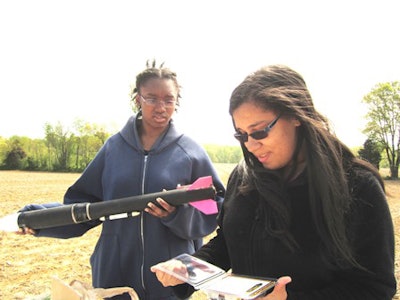 Nia’mani Robinson, left, and Jasmyn Logan aim to use this experience to enhance their chances of getting into the college of their choice, particularly an Ivy League school.
Nia’mani Robinson, left, and Jasmyn Logan aim to use this experience to enhance their chances of getting into the college of their choice, particularly an Ivy League school.CLARKSVILLE, Md. — When Jasmyn Logan and Nia’mani Robinson, age 14, met up to test launch their rockets in the middle of farm here the other day, their purpose was to prepare for the upcoming national Team America Rocketry Challenge.
But as members of “Team Rocket Power” — one of 100 teams that qualified for the national competition set for May 11 in The Plains, Va. — the girls were actually aiming for new heights in more ways than one.
Team Rocket Power is a rarity among rarities. Not only is the team one of nine all-girls teams to qualify for national finals of the Team America Rocketry Challenge, also known as TARC, but their team is also the only all-girls team that is African-American, according to the local chapter of the National Society of Black Engineers, or NSBE.
In order for Team Rocket Power to reach this level of completion, it took months of hard work and sacrifice. Indeed, the girls — both freshmen at Central High School in Prince George’s County — gave up several weekend days out the month since the beginning of the year to design, build and test their rockets, then repeat the process over again if necessary like they would if they were actual engineers.
That’s according to Kamili Jackson, a product assurance engineer at NASA’s Goddard Space Flight Center and chair of the Pre-College Initiative for the Greenbelt Space Alumni Chapter of NSBE, which is working with the girls on Team Rocket Power and other area high school students in an effort to interest them in careers in engineering.
“What made them a good team is they quietly stuck to the goal,” Jackson said. “They put the goal in front of themselves, designed it, tested it. They just kept at it, kept at it.”
The other day, the girls met up on a Sunday morning at Wayback Farm — a remote but scenic stretch of land located amid rolling hills here in Howard County.
Their objective was to launch their pink-finned cardboard rockets to an altitude of 750 feet and then parachute the payload — in this case a large Grade A egg meant to represent the “astronaut” — safely to the ground without cracking, all within 48 to 50 seconds.
On the first test launch, the egg landed safely, but the rocket only reached 705 feet and its payload landed 46 seconds after launch. The altitude and duration of the rocket’s journey may have seemed close to the goal in one sense but they were way off based on the standards used by rocket scientists. In fact, based on the formula used to calculate precision, being that far off would not have even qualified them for the national finals, much less put them in a position to win it.
But the launch was only the first of what would be half a dozen or so test launches this day, and the girls were still assessing the winds and temporarily working without a scale in order to literally weigh what works and what doesn’t.
For Logan and Robinson, winning the competition — which could entitle them to thousands of dollars in scholarship money — isn’t even their paramount goal. The girls indicated they were more interested in the experience and how it could enhance their chances of getting into the college of their choice, particularly an Ivy League school.
“I think it’s very interesting to build a rocket and even if you don’t win it’s a good experience,” Logan said.
“I think it will look good on college applications,” Robinson said.
Jackson said while the NSBE’s Pre-College Initiative has limited data on outcomes for students who participate, all of the students who stuck with the program through high school have gone on to college, mostly to study engineering. The program currently serves about 20 or 25 students per year.
Such outcomes could gradually change the face of engineering, which has traditionally been a male-dominated field.
“People think of it as a man’s game,” said Kevin Johnson, a mentor from the National Association of Rocketry that is helping Team Rocket Power. “But the girls are powerhouses. There are really no barriers.”
Jackson said there’s a need to get more members of underrepresented groups into engineering because there is an ever-growing demand for technology.
“Women should be a big part of that because we’re using technology like everyone else,” Jackson said. “Getting girls into this sort of activity make it accessible to them.”
Logan and Robinson said they never even considered building rockets as something for boys.
“I didn’t even think about it,” Robinson said when asked about what it’s like to be girls in a male-dominated activity.
“I didn’t think of it as a boys’ activity,” Robinson said. “It just seemed like fun.”



















